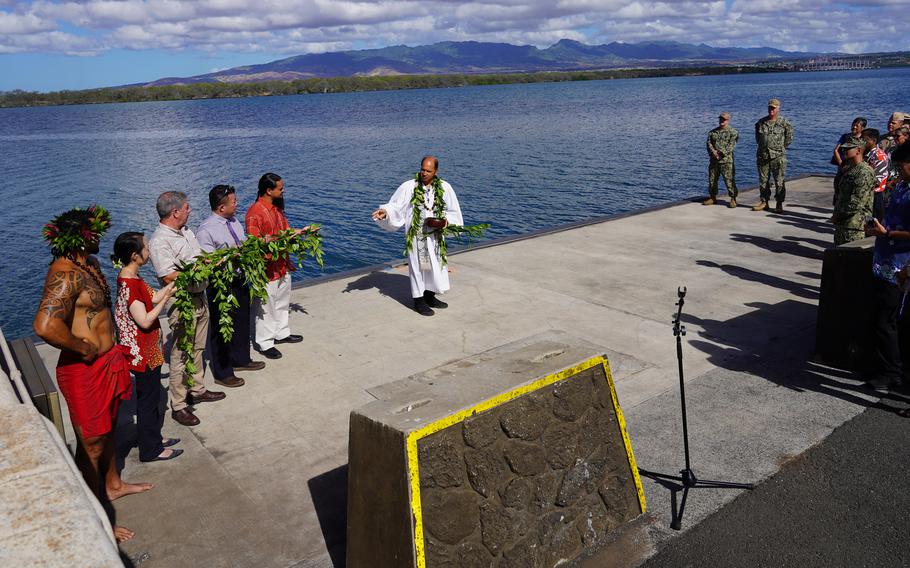
Kahu Kordell Kekoa performs a traditional Hawaiian blessing in August 2023 as the Navy begins construction on a new dry dock at Pearl Harbor Naval Shipyard and Intermediate Maintenance Facility. (Justice Vannatta/U.S. Navy)
JOINT BASE PEARL HARBOR-HICKAM, Hawaii — The Navy has begun the most expensive building project in its history with construction of a $3.4 billion submarine-repair dry dock in Pearl Harbor, Hawaii.
The initial work of installing foundational piles into the harbor waters began this month, with project completion expected by early 2028.
The new dry dock will replace the smallest of the four at the Pearl Harbor Naval Shipyard and Intermediate Maintenance Facility at Joint Base Pearl Harbor-Hickam.
The current dry dock is too small to handle the Navy’s Virginia-class attack submarines, the service’s nuclear-powered subs that are replacing the slightly smaller Los Angeles-class vessels.
The Pearl Harbor project eclipses the $1.7 billion dry dock complex now being built at Portsmouth Naval Shipyard in Kittery, Maine.
All four of the Navy’s public shipyards, which also include Norfolk Naval Shipyard in Virginia and Puget Sound Naval Shipyard and Intermediate Maintenance Facility in Washington, are in dire need of upgrading and modernization, according to a May 2023 report by the Government Accountability Office.
In 2018, the Navy undertook a $21 billion infrastructure plan to upgrade dry docks, buildings and equipment at the shipyards, the report states.
Complex, costly and rare
The oldest dry dock at the Pearl Harbor shipyard was built in 1919, Capt. Richard Jones, commander of the shipyard, said during a media roundtable Friday on the joint base.
The youngest dry dock was completed in 1943 during World War II, he said.
“Dry Dock 3 is too small, too shallow, to accept the Virginia-class submarine,” Jones said.
The new dry dock will be almost twice as deep as Dry Dock 3, he said.
The construction of a dry dock is complex, costly and, thus, rare, Capt. Stephen Padhi, who is overseeing construction, said at the roundtable.
Padhi is commander of Officer in Charge of Construction, Pearl Harbor Navy Shipyard, a newly commissioned command by Naval Facilities Engineering Systems Command.
“The amount of just material that goes into these projects alone is staggering,” Padhi said.
“We’re talking about 250,000 cubic yards of concrete,” he said. “If that were delivered by truck, we’d be talking about 25,000 trucks.”
The project will require about 63,000 tons of steel.
“That’s enough steel to build eight submarines,” Padhi said.
The length of utilities to be installed for the dry dock could “circumnavigate Oahu,” he said.
The price tag for the project reflects “what it takes to build something of this magnitude in Hawaii,” he said. Building the dry dock on a speck of an island in the Pacific costs roughly twice what it would on the mainland because of the cost and complexity of getting materials to Hawaii, he said.
There are also costs for “a very robust degree of environmental protection and permit compliance, safety requirements.”
150-year lifespan
Roy Morioka, a project manager for a pair of firms contracted for the build, said during the roundtable that many of the concrete components needed for the dry dock construction are being made on a peninsula just across the harbor from the shipyard.
Temporary trestles are being built on both sides of the harbor to transport material to and from dockside, Morioka said.
The “good news,” Padhi said, is how long a dry dock can last, referring to the 105-year-old dry dock still being used at the shipyard.
“This dry dock has been designed with a 150-year service life target and could beat that,” he said.
Over the next year, workers will be driving steel piles into the water to create what is essentially the footprint of the new dock, Padhi said. Once that is completed, the area inside can be dewatered.
By 2027, all the “critical facilities” are expected to be in place so that shipyard personnel can begin certification and testing to make way for the first submarine in January 2028, he said.
The entire dry dock project is ultimately about giving the shipyard workforce “infrastructure they need to be successful.”
“And their success translates to the fleet’s success and being able to have the critical, crucial, forward presence that our nation needs with the attack submarine force in the Indo-Pacific region,” Padhi said.